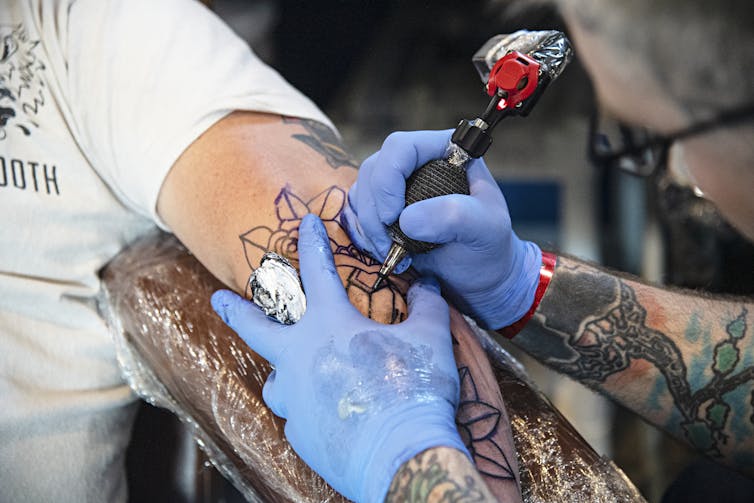What’s in tattoo ink? My team’s chemical analysis found ingredients that aren’t on the label and cou
Some tattoo inks contain unlabeled materials that can cause allergic reactions.

Tattoos are an incredibly common form of permanent self-expression that date back thousands of years. Most tattoo artists follow strict health and sanitation regulations, so you might assume that tattoo inks are carefully regulated, too.
But as work done by my team of chemistry researchers suggests, up to 90% of tattoo inks in the U.S. might be mislabeled. This isn’t just a case of a missing pigment or a minor discrepancy. These inks contained potentially concerning additives that weren’t listed on the packaging.
What’s in an ink?
All inks are made up of one or more pigments, which are molecules that give tattoos their color, and some kind of carrier for that pigment. Before the 20th century, pigments used in tattooing included ash, charcoal, minerals or other natural materials. Around the middle of the 20th century, though, tattoo artists started making their own inks using synthetic pigments and dyes.
Today, nearly all pigments used in tattoos are made of synthetic molecules that allow for bright colors – with the exception of white and black pigments.
In the past few decades, tattoo ink manufacturing has shifted from individual artists making their own to large companies manufacturing inks and selling them to artists. My team wanted to figure out whether these inks contained the ingredients advertised, so we analyzed 54 tattoo inks from the U.S. market.
Unlisted ingredients
More than half the inks my research team analyzed contained unlisted polyethylene glycol, also known as PEG. A variety of medical products contain PEG, including laxatives. It can cause allergic reactions, however, and in the case of tattooing, research has suggested that repeated exposure to PEG could lead to kidney failure.

We also found propylene glycol in 15 inks, though it wasn’t listed as an ingredient in any of them. Propylene glycol is generally nontoxic and structurally similar to glycerin, which is used to thicken the ink. Even though propylene glycol is safe for most people, some people are highly allergic to it. In fact, it was the American Contact Dermatitis Society’s 2018 Allergen of the Year.

An allergic reaction to propylene glycol can cause a skin rash, itching and blistering.
In several inks, my research team found unlisted ingredients that are common in cosmetics but have not been tested in tattoo inks. These include BHT, dodecane and 2-phenoxyethanol. In low concentrations, 2-phenoxyethanol can be a preservative. But the Food and Drug Administration has warned that it could get passed to infants through breastfeeding and lead to vomiting and dehydration in babies.
Of the 54 inks we analyzed, 29 reported the correct pigments, while the rest either did not report or reported the wrong pigments. This is a known problem in tattoo inks that ink manufacturers have not yet addressed.
Pigment concerns
Studies have found that carbon black, the primary black pigment used in tattooing, can be contaminated with some of the same cancer-causing molecules found in car exhaust and cigarette smoke.
Many red, yellow and orange pigments are azo pigments, which contain two connected nitrogen atoms. These pigments give ink bright, vivid colors, but over time they may break down into carcinogens.

Regulations in Europe prohibit the use of copper-containing pigment blue 15 and pigment green 7, which my work observed to be the only blue and green pigments in the inks we tested. The EU banned these pigments over concern that their use in hair dyes may cause bladder cancer, though researchers haven’t studied that connection in tattoos yet.
A new focus on regulation
The FDA is beginning to pay more attention to what is in tattoo inks. In 2022, Congress passed the Modernization of Cosmetics Regulation Act, or MoCRA, which gave the FDA expanded authority to regulate tattoo inks.
The FDA is still deciding how to implement MoCRA, but the act will require accurate ingredient labeling and expand the FDA’s authority to recall ink. In the past, tattoo inks have very rarely, and only voluntarily, been recalled because of bacterial contamination.
So what does this mean for tattoo clients and artists? Right now, there’s no clear research consensus on whether tattoos are safe or not, as they can cause infection and allergic reactions. Plus, tattoos vary widely in size, color and physical location on the body.
Studies like the one from my lab are an important piece in establishing what is actually in a tattoo, so that researchers can better understand any adverse events, such as long-term allergic reactions, that they might cause.
Understanding what is in ink also helps physicians identify what particular health concerns they should look for in tattooed individuals.
The tattoo-related health issues that researchers do know about come from unskilled artists following poor sanitation protocols. To prevent potential health concerns, those considering a tattoo can work with an experienced and trained artist who follows best practices for hygiene and tattoo aftercare.
John Swierk receives funding from National Institute of Health, National Science Foundation, and American Chemical Society Petroleum Research Fund.
Read These Next
School shootings dropped in 2025 - but schools are still focusing too much on safety technology inst
Prevention methods like lockdown drills do not account for many scenarios, including the likely case…
From record warming to rusting rivers, 2025 Arctic Report Card shows a region transforming faster th
The 20th anniversary of the annual report tracks how sea ice, snow cover and many other vital signs…
The North Pole keeps moving – here’s how that affects Santa’s holiday travel and yours
There are actually two North Poles. One has been wandering over northern Canada and north of there for…





